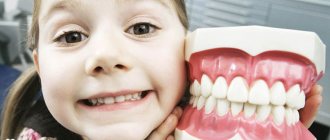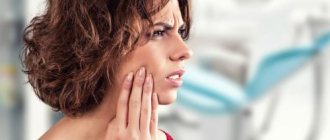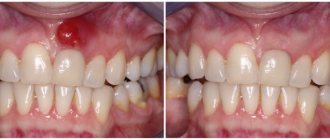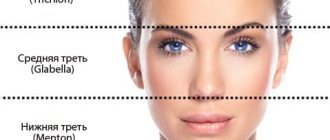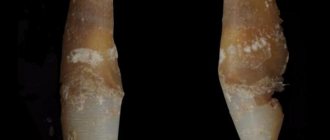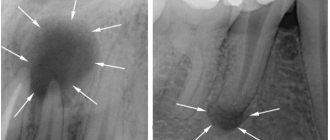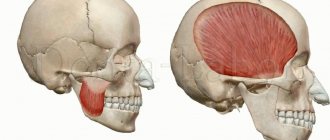Facial swelling is not only a cosmetic defect; if it appears frequently or is accompanied by redness and pain, it is a sign of quite serious health problems that need to be identified and treated.
ALENA PARETSKAYA
Pathophysiologist, immunologist, member of the St. Petersburg Society of Pathophysiologists ANDREY GRACHEV Leading cardiologist of the SM-Clinic holding, MD, academician of the Russian Academy of Medical Sciences
Facial edema is not a separate disease, but only a reflection of an imbalance between retention and excretion of fluid in the body. But what problems in the body can cause the face to swell and how serious is it?
Why does the face swell in adults?
Swelling on the face can occur at different times of the day - mainly in the morning or late afternoon, or they persist throughout the day, decreasing or increasing.
There are two types of reasons:
- physiological (or natural, not associated with diseases), they are usually not pronounced, not very strong, and disappear quickly;
- pathological, can be very strong, with changes in facial features, signs of inflammation, and are often quite persistent.
Each type of edema has the most typical causes; they occur mainly in the morning or evening hours, or do not depend in any way on the time of day. These characteristics are important for the doctor so that he can identify the leading causes and determine the tactics of examination and treatment.
Prevention
It is impossible to prevent the development of sufs.
This is because these fat deposits inevitably appear with age.
But you can slow down degenerative processes by following these preventive recommendations :
- the diet should be balanced : it should include more foods containing vitamin B;
- for normal functioning of the hormonal system and to prevent the formation of bags from overwork, it is necessary to get enough sleep , allocating 7-8 hours a day for sleep;
- stable physical activity has a tonic and , which can be achieved by walking in the fresh air for only half an hour a day;
- You need to drink 1.5-2 liters of water per day to maintain water-salt balance.
Remember! For sensitive skin predisposed to the development of such cosmetic defects, nourishing and moisturizing face creams should be used.
When choosing them, it is better to consult a cosmetologist.
Is there swelling on the face due to heart disease?
Yes, these questions usually worry women, says cardiologist Andrei Grachev.
They run to see a cardiologist when they can’t put a ring on their finger in the morning because it’s swollen or put on makeup because their face is swollen. The patient wants to look great, regardless of age and health status. And this is commendable. Men, as a rule, do not contact a cardiologist with such questions. The peculiarity of this issue is due to the fact that in patients with cardiovascular diseases, as a rule, swelling on the face appears at the final stage of a complication such as heart failure. First, they appear on the legs (the lowest point in relation to the heart), then fluid accumulates in the abdominal cavity, the liver and spleen enlarge (as a blood depot). And only after the fluid reaches the pleural cavities and the heart sac, swelling may occur on the face or hands.
Causes
Know! The amount of fat under the skin in the cheekbone area increases over the years, but a number of predisposing factors can accelerate the process of formation of sufas, including:
- sudden weight gain in general;
- genetic predisposition;
- the formation of constant swelling, as a result of which the skin stretches and the subcutaneous space filled with fat increases.
Painting bags can visually increase due to sagging skin , which with age .
When do they occur most often?
Due to a number of circumstances, adds cardiologist Andrei Grachev, such as the flow of fluid to the upper half of the body in a lying position, changes in the biorhythms of hormone production (more often their active synthesis occurs at night or in the early morning hours), edema syndrome most often manifests itself in the early morning hours .
Morning
If we talk about physiological reasons, morning swelling is usually associated with constant lack of sleep, fasting or strict diets (limiting protein and fats). Sometimes swelling in the morning is caused by the wrong selection of skincare products (face cream, toner or cleanser). Also, morning swelling of the face can be caused by crying or stress in the evening or at night.
Possible swelling of the face in the morning due to an incorrectly selected pillow (it is too high, it provokes a narrowing of the blood vessels in the neck). Another physiological factor is an excess of fried, salty foods or liquids taken in the evening, before bed. In women, facial swelling in the morning can be caused by hormonal fluctuations, PMS or pregnancy. Some women report morning swelling during menopause.
Pathological causes of morning edema are mainly kidney damage. Such swelling is usually soft, mobile, appears on the face after sleep, and the skin acquires a waxy or yellowish tint. The most common causes of facial swelling are:
- glomerulonephritis - the acute form of the disease leads to edema, which lasts up to 2-3 weeks, if the process enters the chronic phase, edema is typical for periods of exacerbation of inflammation;
- Kidney amyloidosis - edema is typical of the second stage (proteinuria), when protein loss occurs and kidney function gradually deteriorates;
- membranous nephropathies - occur after taking certain medications, tumor therapy, acute infectious pathologies. Edema occurs in waves, with sharp or barely noticeable symptoms;
- chronic kidney disease (previously called renal failure) - swelling occurs gradually as renal damage progresses;
- kidney damage in severe systemic pathologies - edema is typical for nephropathy due to diabetes or systemic lupus erythematosus.
Evening
Sometimes facial swelling becomes noticeable in the evening, especially after an active day. Often this is one of the manifestations of pathologies of the cardiovascular system. Often, swelling of the face is accompanied by severe swelling in the area of the extremities - hands and feet, legs. These swellings are denser, the skin has a lower temperature than on other parts of the body, and such swelling goes away slowly. Often occur against the background of the following pathologies:
- amyloidosis of the heart and blood vessels;
- cardiomyopathy;
- sclerotic heart disease (cardiosclerosis);
- certain types of arrhythmia;
- constrictive pericarditis;
- some heart defects;
- arterial hypertension;
- cardiac lesions due to rheumatism.
Day
Sometimes facial swelling is most pronounced during the day or its appearance is not clearly related to the time of day. Among the main pathologies that lead to such edema are endocrine disorders - especially a lack of thyroid hormones (hypothyroidism). Facial swelling is especially pronounced with congenital hypothyroidism, in pregnant women or with autoimmune thyroiditis, cytokine-induced thyroiditis.
Rapidly increasing swelling of the face during the day can be a sign of allergies - to food, insect bites, cosmetics, medications and even cold. Sometimes facial swelling occurs during an attack of bronchial asthma due to difficulty breathing and fluid retention in the veins.
Facial swelling is possible in people who smoke and drink alcohol. This is due to the increased work of the lymphatic system to remove toxins from tissues.
Severe swelling of the face during the day is possible with respiratory infections and their complications - sinusitis, tonsillitis, frontal sinusitis. Swelling of the face is possible with a deficiency or excess of vitamins (especially fat-soluble ones).
Treatment
Pre-hospital assistance
The vast majority of causes of cheek swelling require medical intervention and cannot be eliminated through self-medication. The exception is minor injuries: bruises, small hematomas of the cheek, to which cold should be applied in the first days, and then dry heat. In case of intense pain, increasing swelling, or signs of general intoxication, you should consult a doctor as an emergency.
Conservative therapy
Treatment tactics are determined by the characteristics of the disease. In case of dental pathologies, complex treatment of periodontitis or pulpitis is performed. Patients may be prescribed the following medications:
- NSAIDs
. Medicines containing nimesulide are effective for toothache, injuries, and inflammatory processes. Reduce pain, swelling, inflammation. They are symptomatic remedies and do not eliminate the cause of the disease. - Analgesics
. Recommended for severe pain. They should be taken only as prescribed by a doctor, since they can, to a certain extent, neutralize the manifestations of the purulent process. - Antihistamines
. Block the production of histamine, eliminating the manifestations of allergic reactions. 2nd generation drugs and their active metabolites have the fewest side effects. - Antiseptics
. They are used as rinses on their own or after surgery. - Antibiotics
. Indicated for purulent and non-purulent inflammatory processes caused by bacterial microflora.
Along with drug therapy, physiotherapeutic procedures are carried out according to indications. Laser therapy, medicinal electrophoresis, UHF, and other techniques are used.
Surgery
Taking into account the characteristics of the pathological process, the following surgical interventions can be performed:
- Dental diseases
: tooth extraction, opening of a submucosal or subperiosteal abscess, removal of a salivary gland tumor, opening, drainage for purulent mumps. - Traumatic injuries
: osteosynthesis of the zygomatic bone, upper or lower jaw, splinting of the jaw, ligature binding of teeth. - Ophthalmological pathologies
: dacryocystorhinostomy, extirpation of the lacrimal sac. - Nervous diseases
: thrombectomy, decompression hemicraniotomy for cavernous sinus thrombosis. - Infectious processes
: opening of a boil. - ENT diseases
: open or endoscopic maxillary sinusotomy, micromaxillary sinusotomy, excision of maxillary sinus cyst.
How to quickly relieve facial swelling in adults
If this is physiological swelling of the face, not associated with serious pathologies that require medical supervision and the use of selected medications, excess fluid can be eliminated through certain simple measures and actions.
Taking a contrast shower or washing with cold/hot water. This method refreshes, increases tissue tone, enhances the outflow of fluid from the skin and reduces swelling.
Using ice – a couple of pieces of ice will help deal with swelling on the face quickly and effectively. In addition, you can prepare herbal decoctions with a tonic effect in advance and freeze them, using them for washing.
Facial massage is an effective remedy that helps improve microcirculation and swelling. Manual massage, the use of rollers, ice cubes, and cold spoons help. Sometimes you can first wipe your face with green tea and apply compresses with it to your face and eye area.
How to get rid of bags under the cheekbones: debunking myths
The first thing that comes to mind: massages, medicinal cosmetics, vitamins... This is a good option. It will be great if you add fresh air, proper nutrition and exercise! You will look much better and feel incredibly healthier.
There is only one BUT: these wonderful measures will in no way help you remove the swelling on your cheekbones under your eyes.
Let us remind you: we are dealing with zygomatic hernias, with some mini-containers of adipose tissue that fall down under the influence of the universal law of attraction. Judge for yourself, how can you solve this problem with the most wonderful massage and the longest walks? That's it, no way.
Advantages of contacting Listratenkov K.V.
You can remove Bisha's lumps in Moscow by contacting Dr. Listratenkov K.V. He carries out all surgical interventions himself. On the website you can clearly see the result after removing Bisha's lumps (before and after). The main principle of work is a trusting relationship between the doctor and patients.
Additionally, free consultations from a surgeon are provided: you can visit the website by providing contact information. In the near future, Kirill Viktorovich will give a detailed answer to this.
Positive patient reviews confirm the safety of surgery to remove Bisha's lumps (before and after photos are presented on the website). The Center for Aesthetic and Laser Medicine has been operating for more than 15 years. During this time, we managed to make several thousand patients happy. The working hours are convenient: the doctor sees from 10:00 to 20:00 from Monday to Saturday, which is suitable even for people with an irregular work schedule.
To make an initial appointment, just contact the administrator at the specified number or leave a request online, leaving contact information, the expected date and time of the appointment.
Approach to treating the disease in our clinic
Our clinic is an example of integrative medicine: a synthesis of Eastern and Western approaches to treatment. In addition to neutralizing the causes of the disease and restoring the functionality of the HFNS, we restore the disturbed energy balance of the body and the integrity of its structure. Therefore, patients have the strength to cope with the disease and recover much faster than using only the usual medical protocol. All patients are different, so the appointment after the examination is individual.
We combine proven techniques of the East and innovative methods of Western medicine.
Read more about our unique method of treating arthrosis
What is arthrosis of the TMJ
Arthrosis of the TMJ is a disease that destroys the components that form the joint (Greek arthron joint, suffix oz - destruction). First, the articular cartilage is destroyed, then the following occurs in the articular elements:
- proliferation (tissue growth);
- calcification (calcium redistribution) and ossification of cartilage;
- hyperplastic (proliferation) and destructive (destruction) processes in the epiphyseal parts of bones (these are the rounded ends of the bones - the head and fossa);
- reactive-inflammatory (from the word “response”) changes in the synovial membrane;
- fibrosis (overgrowth of connective tissue) with hardening of the joint capsule, which affects nearby muscles, tendons and ligaments.
With the destruction of cartilage, its shock-absorbing functions are reduced, and impacts are transmitted directly to the bone. Patients involuntarily increase the destruction by reacting emotionally to events - they clench their teeth, not daring to say too much, with a “stony” face and tense muscles, compressed blood vessels and stress hormones, they face the blows of fate. The amount of nutrients decreases, the TMJ would be happy to recover - but there is no building material. Instead, the epiphyseal sections of the bone are flattened under pressure, and bone growths appear on them.
Then the joint enlarges, compressing the nerve endings located nearby. The pain radiates to the ear, back of the head, and teeth. When the jaw moves, a specific clicking sound appears (occlusion-articulation syndrome).
ICD codes M.19. 0 (1, 2, 8 – last digit changes)
Diagnostics
In the initial stages, arthrosis of the jaw is asymptomatic (more precisely, if there is pain, discomfort - they are attributed to a cold, problems with teeth, inflammation of the facial nerve, etc.). When constant pain appears, the face loses symmetry, it is impossible to chew - the patient begins to visit doctors.
Remember: at the slightest suspicion of TMJ arthrosis, you should consult a doctor; it is impossible to make a diagnosis yourself (if you are not an orthopedist or a healer).
In the clinic to confirm the diagnosis you will need:
- take blood tests (clinical - to identify an infectious-inflammatory process, biochemistry - for arthrosis, biochemical parameters should be normal);
- take an x-ray in 2 projections (the image clearly shows the deformation of the osteophyte, the narrowing of the joint space, but the articular cartilage is not displayed in the image, and it is impossible to assess the degree of destruction of the TMJ in the early stages);
- undergo an MRI or computed tomography (MRI uses magnetic waves, and computer tomography uses X-rays, so in the early stages, MRI is an advantage).
Occasionally, an ultrasound of the joint is prescribed. In addition, a personal examination is required, because often it is necessary to treat not only arthrosis, but also to remove defects in the dentition, and to treat the accompanying inflammation of nearby tissues.
How dangerous is the disease?
TMJ arthrosis is silent and unnoticeable; people live with the disease for years without even knowing about the problem. But in vain.
Degrees of TMJ arthrosis
In the Russian Federation, the Kosinskaya classification of arthrosis has been adopted, which takes into account both symptoms and radiographic data. However, the TMJ is an exception to the rule: the joint “hangs”, held by muscles and ligaments, and does not experience weight loads comparable to other joints.
When at stage 1 according to Kosinskaya the joint space narrows, the pressure on the jaw simultaneously increases, which leads to problems with the teeth, but maintains the distance. The process is gradual, so this moment can be recorded on an MRI, but since there are no symptoms characteristic of the disease in the initial stage, it cannot be said unequivocally that this is stage 1 arthrosis. Only at stage 2, when symptoms appear (pain, facial asymmetry, etc.), and the patient finally consults a doctor, is a diagnosis made.
Stage 3 according to Kosinskaya: absence of joint space, sclerosis, necrosis, inability to open the mouth, chew and speak.
Damage to the TMJ by arthrosis
Possible complications
Arthrosis is not only a problem of the joint. Compensatory, in an effort to maintain chewing function, the body redistributes the load, which leads to tooth loss and rapid wear.
The previous diseases will be reflected in TMJ synovitis, and then the inflammatory process will affect the ear and nose (with decreased hearing, nasal congestion on one side), a headache will appear, which can radiate to the neck, back of the head and not stop.
The face will lose symmetry and become pasty (the skin appears loose, finely swollen, and grayish in color). Feeding is possible only through a tube; already at the second stage the ability to fully open the mouth is lost
Any localization and form of arthrosis has serious complications, so you should not delay treatment.
See how easily the disease can be cured in 10-12 sessions.
Exacerbations
Osteoarthritis is not arthritis; a chronic disease does not have periods of exacerbation. But this does not mean that the pain will be equally aching. The inflammatory process (cold, infection, virus) spreads to the joint with the development of synovitis. Swelling and pain appear, which can appear at any radial point (from the teeth to the back of the head). The source of inflammation expands, the oral cavity, ears, and breathing through the nose are at risk.
You need to understand that the brain is located nearby. And you shouldn’t wait for necrotic tissue to give rise to oncology.
Frequently asked questions about the disease
Who treats arthrosis of the temporomandibular joint?
The treatment is complex. If there is no gnathologist in the medical institution, treatment is carried out by a surgeon or orthopedic traumatologist. In this case, a dentist, a neurologist, an otolaryngologist and, if necessary, a rheumatologist and an infectious disease specialist must be involved.
Is it possible to cure TMJ arthrosis?
If bone growths have begun, the process can be stopped, but it will not be possible to defeat the disease when the joint is young and healthy. But if you start treatment at least at stage 2 of the disease, you will be able to get rid of the symptoms, stop the destruction and even restore cartilage tissue.
Why is arthrosis of the TMJ dangerous?
Deformation in the joint leads to facial asymmetry, secondary inflammation spreads to the nasopharynx and ear. Due to spasmed muscles, teeth wear out and fall out. The skin on the face becomes pasty and ages quickly.
What is the difference between arthrosis and TMJ arthritis?
Arthritis is an inflammatory process in the temporomandibular joint of infectious-allergic, traumatic, autoimmune, etc. origin, which in advanced cases can lead to arthrosis. For example, a purulent infection (purulent otitis, boil in the ear canal, flu, sore throat, mumps, etc.) infects the joint fluid. The inflammatory process spreads to the joint capsule (the local temperature rises, the blood vessels of the heads of the bones grow and dilate). The purulent process then dissolves the cartilaginous surface and meniscus, and then destroys the bone tissue, leading to arthrosis. Arthrosis destroys the joint asymptomatically at the first stage and without an acute inflammatory process. The cartilage loses moisture, dries out, and cracks. The bone then grows, changing the structure of the joint.
Literature
- Evdokimenko P.V. Arthrosis
- Petrosov Yu. A., Kalpakyants O. Yu., Seferyan N. Yu. Diseases of the temporomandibular joint
Themes
Arthrosis, Joints, Pain, Treatment without surgery Date of publication: 10/08/2021 Date of update: 11/01/2021
Reader rating
Rating: 4.5 / 5 (2)
Advantages and disadvantages of surgery
Despite the fact that Bisha's lumps do not carry a functional load for an adult, not everyone supports the decision to remove them. Among the main arguments of opponents are the risk of negative consequences, low effectiveness in people with full faces, the visual addition of several years due to sunken cheeks, and the inability to return everything back if the result is not satisfactory. However, the technique is still in great demand because it has a number of advantages. These include:
- correction. By eliminating the fat cells under the cheekbones, it is possible to give the lower part of the face clarity and definition. This will create a rejuvenating effect;
- modeling. Often, people with small facial features have lumps of non-standard sizes, which disrupts the proportions of the face. With the help of surgical intervention, it is possible to carry out modeling and make the features more proportional;
- elimination of excess fat. Unlike the popular procedure - liposuction, a lasting effect is observed during bishectomy. The face after surgery looks more refined;
- safety of the technique. As practice shows, the likelihood of complications developing is minimized;
- eliminating signs of aging. When the cheeks sag, a person's overall facial features change. This leads to the appearance of deep skin folds. As a result of surgery, the skin is tightened and nasolabial wrinkles are eliminated;
- weight loss Even intense physical activity and exhausting diets are not always able to get rid of chubby cheeks. Thanks to bishectomy, a visible facial slimming effect is guaranteed.
First roles
In recent years, it has been believed that the leading roles in the appearance of rosacea are played by innate immunity, microbiota and the inflammatory process. Innate immunity triggers the production of antimicrobial peptides and proinflammatory cytokines. “With rosacea, their levels increase sharply. For example, the activity of antimicrobial peptides cathelicidins increases 10 times, and the level of peptidase increases 10 thousand times! - continues Elena Arabian. — Flora also works in a special way. Staphylococcus is of great importance here, but the leading role is played by mites of the genus Demodex. Together with bacteria, fungi and viruses, they are a representative of the microbiome, but with rosacea their increased density is noted: it has been proven that they provoke inflammation. One of the reasons why this microscopic mite becomes pathogenic is low skin moisture.
Factors that provoke exacerbation of chronic rosacea are considered to be stress, extreme cold or heat, alcohol intake, hot and spicy foods. Recently, soy sauce and vanilla have been added to the list of food provocateurs. But coffee and drinks containing caffeine have been rehabilitated.
Concomitant diseases play a major role in the development of rosacea. First of all, we are talking about gastrointestinal problems, celiac disease, Crohn's disease, infection caused by Helicobacter pylori, irritable bowel syndrome - these are all background conditions. Recent studies have shown a connection with hypertension, cardiovascular pathology, anxiety disorders, depression and diabetes. Considering all these factors, it is clear that patients with rosacea require a multidisciplinary approach.”
Clinical symptoms of rosacea are redness of the skin, the appearance of telangiectasia (dilation of small vessels) and various rashes: papules, pustules, fimas (inflammatory elements, rosacea, bumpy formations).
Treatment of headaches and facial swelling
Treatment tactics will depend on the exact diagnosis. It will include drugs to eliminate the underlying cause of the disorders, as well as to symptomatically eliminate swelling. The doctor will prescribe a medication regimen, which may include the following steps:
- for diseases of the cardiovascular system - cardiac glycosides, drugs for vasoconstriction, adrenergic blockers and anticoagulants;
- kidneys and excretory system - antibiotics as necessary, supportive agents;
- for allergies - antihistamines and hormonal anti-inflammatory drugs;
- hypothyroidism - iodine preparations, as well as levothyroxine;
- intoxication - gastric lavage and infusion therapy may be necessary.
Diuretics are prescribed to remove excess fluid. They are used for diseases of the cardiovascular system and for slowing down lymphatic drainage. However, such measures are temporary, so it is important to choose an effective treatment regimen that will eliminate the main cause of edema.

